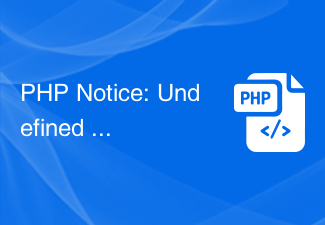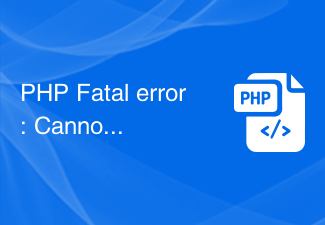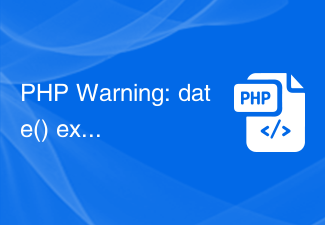 Backend Development
Backend Development Python Tutorial
Python Tutorial How to solve the parameter too complex error in Python function?
How to solve the parameter too complex error in Python function?In the process of programming in Python, the parameters in functions often become very complex. Once the parameters in the function are too complex, we will encounter some errors. In this article, we will delve into the problem of complex parameters in Python functions and provide some solutions to help you better understand and deal with this problem.
Why do you encounter parameter problems in Python functions?
In Python, a function is a reusable block of code that performs a specific task. A function consists of two parts: function definition and function call. The function definition contains the code for the task to be performed, while the function call is where the code is actually executed in the rest of the program.
In the function definition, parameters allow us to pass data to the function so that the data can be processed in the function. For example, we can pass two numbers as arguments to a function and then sum them within the function. The use of this parameter is relatively simple and clear, and there will be no parameter problems. However, when using complex parameters in a function, we may encounter some problems, such as the following:
- Too many parameters: When there are many parameters that need to be passed, the code will become very Complex and difficult to understand.
- Difficulty in parameter order: Sometimes there are multiple parameters and the order can become confusing, making it difficult to write correct function calls.
- Trouble with default parameters: Sometimes, functions have default parameters, but they forget to modify the parameters when calling.
How to solve parameter problems in Python functions?
Although parameter problems in Python functions are very common, we can use the following methods to solve them:
- Reduce the number of parameters: We should reduce the number of parameters in the function as much as possible. A good rule of thumb is that each function only requires a maximum of three parameters. If you encounter more parameters, consider refactoring the code to use more classes or encapsulate more data structures.
- Use named parameters: Python allows you to use named parameters. Named parameters allow you to specify parameter names in function calls instead of parameter values. This approach makes the code easier to read and understand.
- Documented parameters: In the function definition, we can add a documentation string to describe the function and use of the function. In the docstring we should also include details about the function parameters. This will help other developers better understand the intended purpose and proper use of the code. An example of the docstring method is as follows:
def foo(a, b, c):
"""
This function takes three arguments:
a: An integer
b: A string
c: A list of floats
"""
# 函数实现- Use type hints: Type hints can help you detect errors in your code at compile time. It enforces the type of parameters and the type of return value in a function. This improves code clarity and makes collaborative work easier by increasing code readability. Type hinting works as follows:
def foo(a: int, b: str, c: list[float]) -> bool:
# 函数实现- Simplify default parameters: Try not to use default parameters in functions. If you must use default parameters, make sure that the values of the default parameters are very unambiguous and do not need to change these default values based on the parameters that have been passed.
Conclusion
In Python, functions are the key to code reuse and modularization. Using parameters in function definitions and calls is a common need. Try reducing the number of parameters, using named parameters, documenting parameters, using type hints, and trying to avoid default parameters. These methods can help you solve the problem of overly complex Python function parameters that you may encounter. These methods also ensure that your code is more readable and maintainable. Try to apply these methods and make your Python code more readable and maintainable.
The above is the detailed content of How to solve the parameter too complex error in Python function?. For more information, please follow other related articles on the PHP Chinese website!
 PHP Warning: mysqli_query(): Empty query的解决方法Jun 22, 2023 pm 04:45 PM
PHP Warning: mysqli_query(): Empty query的解决方法Jun 22, 2023 pm 04:45 PM在使用PHP开发Web应用时,经常会遇到各种各样的问题。其中,一些常见的问题是与MySQL数据库相关的问题。有一种问题是“PHPWarning:mysqli_query():Emptyquery”的错误。本文将介绍此错误的原因以及解决方法。首先,让我们看看这个错误表示什么。当您使用mysqli_query函数执行MySQL查询时,如果该查询为空,则会
 PHP Notice: Undefined property: stdClass::$的解决方法Jun 22, 2023 pm 10:24 PM
PHP Notice: Undefined property: stdClass::$的解决方法Jun 22, 2023 pm 10:24 PM在使用PHP编写代码时,我们经常会看到这样的错误提示:“PHPNotice:Undefinedproperty:stdClass::$”。这个错误提示通常是由于在使用对象的属性时,该属性不存在而引起的。在本文中,我们将讨论如何解决这个问题。首先,我们需要了解这个错误提示的原因。当我们使用对象的属性时,PHP会首先检查该属性是否存在。如果该属性不存在,
 PHP Fatal error: Cannot redeclare的解决方法Jun 22, 2023 pm 07:43 PM
PHP Fatal error: Cannot redeclare的解决方法Jun 22, 2023 pm 07:43 PM在使用PHP进行开发的过程中,有时候会遇到“PHPFatalerror:Cannotredeclare”错误,这个错误通常会出现在如下情况:在PHP代码中多次include/require同一个文件。在代码中定义了和已有的函数/类重名的函数/类。这个错误会导致程序无法继续执行,为了解决这个问题,我们需要了解其产生原因和解决方法。产生原
 PHP Warning: date() expects parameter 2 to be long, string given的解决方法Jun 22, 2023 pm 08:03 PM
PHP Warning: date() expects parameter 2 to be long, string given的解决方法Jun 22, 2023 pm 08:03 PM在使用PHP程序开发时,经常会碰到一些警告或者错误的提示信息。其中,可能出现的一个错误提示就是:PHPWarning:date()expectsparameter2tobelong,stringgiven。这个错误的提示信息意思是:函数date()的第二个参数期望是长整型(long),但是实际传递给它的是字符串(string)。那么,我们
 PHP Notice: Trying to get property ‘的解决方法’ of non-object的解决方法Jun 22, 2023 am 11:51 AM
PHP Notice: Trying to get property ‘的解决方法’ of non-object的解决方法Jun 22, 2023 am 11:51 AM当我们在使用PHP进行开发时,有时会遇到”Tryingtogetproperty‘的解决方法’ofnon-object”的错误提示。这个错误的原因一般是因为程序中对一个不存在或者未实例化的对象进行访问,导致了PHP解析器无法识别该对象的属性或方法。那么,如何解决这个错误呢?下面我将为大家介绍几种可能的解决方法。一、检查代码首先,我们需要将出错的代
 TranslucentTB不起作用:如何解决Jun 06, 2023 am 08:21 AM
TranslucentTB不起作用:如何解决Jun 06, 2023 am 08:21 AMTranslucentTB是寻求时尚简约桌面外观的Windows11爱好者广泛使用的工具,遇到了障碍。自从发布以来Windows11内部版本22621.1344(22H2)28年2023月日,TranslucentTB对大多数用户不起作用。此错误使用户努力应对其任务栏的有限自定义选项。用户在寻求克服这一挫折的解决方案时,挫败感显而易见。在最近的Windows11更新之后,TranslucentTB无法正常工作的问题已在多个在线平台上广泛报道,包括论坛和社交媒体。用户一直在分享他们的经验,拼命寻找
 PHP Notice: Undefined index:的解决方法Jun 22, 2023 am 10:15 AM
PHP Notice: Undefined index:的解决方法Jun 22, 2023 am 10:15 AM当使用PHP开发Web应用程序时,经常会遇到“PHPNotice:Undefinedindex:”这样的错误消息。此错误消息通常与数组相关。在PHP中,当我们使用未定义的数组索引时,就会收到这种类型的错误消息。这通常会发生在以下情况下:尝试访问不存在的数组元素尝试使用错误的键来访问数组在本文中,我们将探讨如何解决此错误,并提供一些常见的应用程序开发实践
 PHP Notice: Undefined property: stdClass::$name的解决方法Jun 22, 2023 pm 10:09 PM
PHP Notice: Undefined property: stdClass::$name的解决方法Jun 22, 2023 pm 10:09 PM在使用PHP开发项目时,经常会遇到各种警告和错误信息。其中,PHPNotice:Undefinedproperty:stdClass::$name是比较常见的一种警告提示。这种提示通常出现在尝试访问一个对象属性,但该属性并不存在的情况下。本文将介绍这种警告的解决方法。原因分析在PHP中,stdClass是一个类似于数组的标准类,在没有指定类的情况下创


Hot AI Tools

Undresser.AI Undress
AI-powered app for creating realistic nude photos

AI Clothes Remover
Online AI tool for removing clothes from photos.

Undress AI Tool
Undress images for free

Clothoff.io
AI clothes remover

AI Hentai Generator
Generate AI Hentai for free.

Hot Article

Hot Tools

SublimeText3 English version
Recommended: Win version, supports code prompts!

SAP NetWeaver Server Adapter for Eclipse
Integrate Eclipse with SAP NetWeaver application server.

WebStorm Mac version
Useful JavaScript development tools

SublimeText3 Linux new version
SublimeText3 Linux latest version

MinGW - Minimalist GNU for Windows
This project is in the process of being migrated to osdn.net/projects/mingw, you can continue to follow us there. MinGW: A native Windows port of the GNU Compiler Collection (GCC), freely distributable import libraries and header files for building native Windows applications; includes extensions to the MSVC runtime to support C99 functionality. All MinGW software can run on 64-bit Windows platforms.





